



Importance of Pullet Feeding Programs in Ensuring a Profitable Laying Flock
Technical Information bulletin 1 from the Canadian Poultry Industry Council. J. D. Summers reviews the importance of reaching a balance between physical and economic performance.A significant amount of research has been undertaken to study feeding programs for egg production type pullets to point of lay. While there does not appear to be a consensus on the proper levels of dietary protein and energy required during the growth phase, there appears to be limited agreement that body weight and/or body composition at sexual maturity are probably the important considerations (Leeson and Summers, 1987; Summers et al., 1987; Leeson et al., 1991).
Brody et al. (1980), working with broiler breeders, suggested that there was an “age factor” which had to be met regardless of body weight and/or composition before the initiation of egg production. Small egg size, which persists with pullets brought into production at an early age (Leeson and Summers, 1980-81), might suggest that the “age factor” may also be an important consideration for a profitable layer. Age at 5 or 50% production, or some specific calendar age, is often used to refer to “age at sexual maturity of a flock.” A pullet really has two stages of sexual maturity and these are determined by growth rate and body composition rather than some specific calendar age.
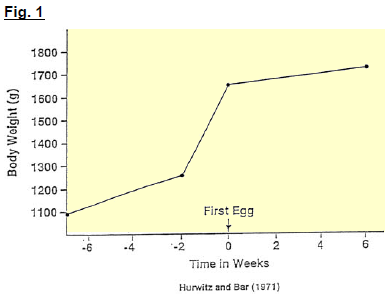 |
The first stage of sexual maturity is noted by the appearance of physical characteristics, such as comb development. The bird is at the point of beginning the move from a juvenile to an adult. This initial stage of the onset of sexual development may be a matter of body size and/or composition. Body weight at this time can be considered to be that of a “mature pullet”. During this transformation period major physiological changes take place especially with the oviduct and the liver as the pullet gets ready to start her egg laying cycle. Such changes take place quickly, within 2 to 3 weeks, as demonstrated in Fig. 1 and during this time the bird will increase body weight by 200 to 300 grams. The second stage of sexual maturity is the laying of the first egg and thus the beginning of the egg production period. This stage of sexual development could well be age related. By the time the hen lays her first egg she has reached a mature body weight and weight gain beyond this point will be small and will be influenced by the type of feeding program employed (Leeson and Summers, 1978) (eg. full-fed, restricted, some type or degree of self selection).
Pullet growers today must manage their flocks so that the birds are in proper condition (which can only be estimated by body weight), at these two stages of sexual maturity, if a profitable laying flock is to be achieved. While lighting programs play a role in well managed layer flocks, the mistake is often made of using light stimulation to bring an underweight flock into production. Such flocks are seldom without problems.
Many factors can influence body weight of pullets during the growing period. However, as the pullet approaches sexual maturity body weight begins to plateau and thus the influence of earlier nutrition or management factors becomes of lesser importance. This is demonstrated and discussed in the report of Leeson and Caston (1991). In Table 1 it can be noted that regardless of diet energy concentration or room temperature, body weight of White Leghorn type pullets was similar at 18 weeks of age.
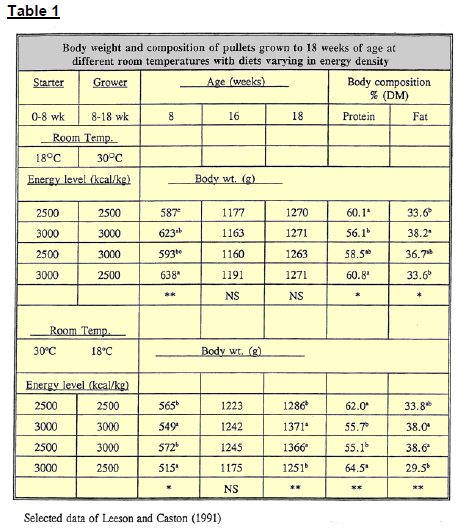
However, it may also be noted that pullets fed diets containing 3000 as compared to 2500kcal ME/kg from 8 to 18 weeks of age, were always “fatter” at 18 weeks of age. This difference in body composition could be an important consideration depending on the time of year the pullets are coming into production. For example pullets coming into production during the hot summer months usually benefit from having greater body energy reserves. Heavier pullets, carrying more body fat, were avoided in the past due to potential “pick out” problems. However, with the modern day pullet experiencing low feed intake at the onset of lay and having the genetic potential to rise quickly to peak production, good body reserves at the onset of production are essential if satisfactory performance in the laying house is to be achieved.
 |
In Figure 2 relative performance is shown for pullets to 4 weeks of age when fed diets equal in energy (2900 kcal ME/kg) but containing 15, 18 or 21% protein. Percent change in body weight, tibia weight and tibia length are shown as dietary protein level is increased from 15 to 21%. It is obvious that weight gain is a better measure of pullet development than is tibia length or weight. This is not surprising as it is only logical that nutrients are preferentially partitioned to skeletal development at an early age rather than to more labile tissues such as muscle. The recent report of Leeson and Caston (1993) adds confirmation to the above conclusion. They showed that pullets reared at high versus low temperatures had greater shank length, especially when expressed per unit body weight, even though feed intake was markedly reduced. Thus nutrients were being preferentially diverted to skeletal growth resulting in birds of acceptable shank length but lacking in body weight and/or condition.
It is important to get pullets off to a good start and thus a relatively high density starter diet should be fed. However, this diet does not have to be in excess of 18 to 20% balanced protein or 2800 to 2900 kcal of metabolizable energy/kg. In most cases nothing is gained by feeding the starter diet beyond 4 weeks of age, since pullets will, as mentioned previously, compensate during the later stage of the growing period for any reduced gain to 4 weeks of age.
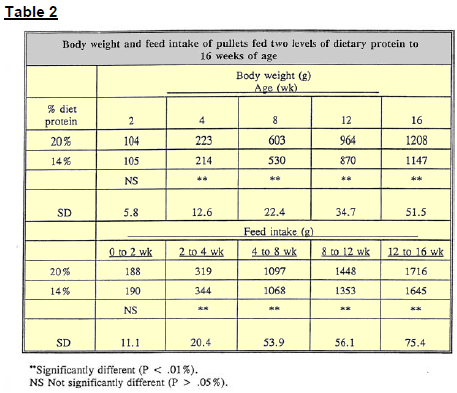
While it is important that pullets be well fed during the growing period, this does not mean that they have a high requirement for protein. In Table 2 is shown the performance of White Leghorn pullets fed either 20 or 14% protein, corn, soybean meal diets from hatch until 16 weeks of age. Pullets fed the higher protein diet weighed approximately 60 grams or 5% more at 16 weeks than did birds fed the lower protein diet. It is interesting to note that up to 4 weeks of age birds fed the lower protein diet consumed more feed than those fed the higher protein diet, thus suggesting that birds may have increased feed intake to account for an insufficient level of dietary protein. However, beyond 8 weeks of age birds fed the lower protein diet consumed less feed, suggesting that the birds fed the higher protein diets were consuming more energy (feed) to make up for their higher protein intake. While there was approximately 14% difference in the weight of the pullets, fed the two different diet protein levels at 8 weeks of age, this was reduced to only around 5% at 16 weeks of age. This “Catch Up” in growth as the pullet approaches sexual maturity is similar to that report by Leeson and Caston (1991). From the feed and nutrient intake shown in Table 3, it is obvious that the pullets were eating to satisfy an energy not a protein and/or essential amino acid requirement.
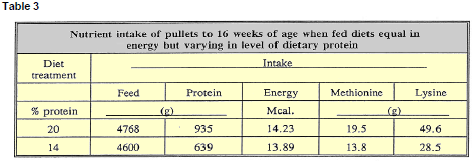
The above pullets were placed on similar laying diets at 16 weeks of age. Performance in the laying house was identical, thus demonstrating that underweight pullets can quickly attain mature body weight and composition if placed on higher density diets several weeks before production commences.
Table 4 demonstrates how quickly pullets adjust to a normal laying pattern regardless of previous nutrition. From 16 to 20 weeks of age pullets were fed diets varying widely in protein and energy concentration (a control diet containing 17% protein and 2850kcal ME/kg, or diets where nutrients were diluted or increased by 15%). At 20 weeks of age, all birds were placed on a regular laying diet. Body weight at point of lay, subsequent egg production and egg size, were little affected by these prelay dietary treatments. It should be pointed out that a good pullet weight was reached at 20 weeks of age. This is obviously the key to the similar laying house performance of the pullets fed the three different pre-lay diets.
Further evidence that good body weight of the pullet at point of lay is a very important consideration for a profitable laying flock is demonstrated in Figures 3, 4 and 5 where birds were fed diets containing 17 or 13% dietary protein and 2600 or 2900kcal of ME, in a factorial arrangement, starting at 18 and ending at 55 wk of age. Since there was no protein x energy interaction only the main treatment effects are shown. There were no significant differences noted for percent egg production for any of the dietary treatments (Figure 3). Feeding 17 versus 13% protein resulted in significantly larger eggs beyond 24 weeks of age or peak production (Figure 4). However, no difference in egg weight was noted between the 2600 and 2900kcal diets. It should be pointed out that specific dietary protein and energy responses are discussed above. Where diets vary in level of energy as well as protein then no specific conclusions can be drawn as to the affect of either nutrient as there will be an interaction between the two with respect to intake.
The above pullets were placed on similar laying diets at 16 weeks of age. Performance in the laying house was identical, thus demonstrating that underweight pullets can quickly attain mature body weight and composition if placed on higher density diets several weeks before production commences. Table 4 demonstrates how quickly pullets adjust to a normal laying pattern regardless of previous nutrition. From 16 to 20 weeks of age pullets were fed diets varying widely in protein and energy concentration (a control diet containing 17% protein and 2850 kcal ME/kg, or diets where nutrients were diluted or increased by 15%). At 20 weeks of age, all birds were placed on a regular laying diet. Body weight at point of lay, subsequent egg production and egg size, were little affected by these prelay dietary treatments. It should be pointed out that a good pullet weight was reached at 20 weeks of age. This is obviously the key to the similar laying house performance of the pullets fed the 3 different prelay diets. Further evidence that good body weight of the pullet at point of lay is a very important consideration for a profitable laying flock is demonstrated in Figures 3, 4 and 5 where birds were fed diets containing 17 or 13% dietary protein and 2600 or 2900kcal of ME, in a factorial arrangement, starting at 18 and ending at 55 weeks of age. Since there was no protein x energy interaction only the main treatment effects are shown. There were no significant differences noted for percentage egg production for any of the dietary treatments (Figure 3). Feeding 17 versus 13% protein resulted in significantly larger eggs beyond 24 weeks of age or peak production (Figure 4). However, no difference in egg weight was noted between the 2600 and 2900kcal diets. It should be pointed out that specific dietary protein and energy responses are discussed above. Where diets vary in level of energy as well as protein then no specific conclusions can be drawn as to the affect of either nutrient as there will be an interaction between the two with respect to intake.
Regardless of essential amino acid supplementation higher protein levels usually give larger egg size. However, the economics of feeding 4% more protein to achieve a 1- to 2-gram difference in egg weight would have to be evaluated.
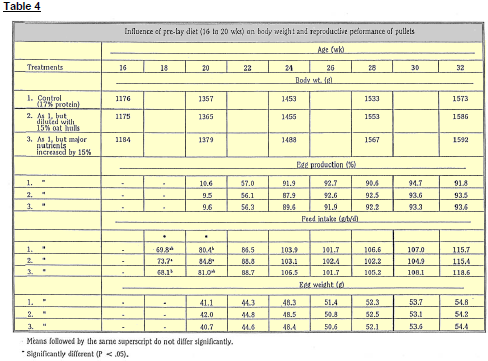
 |
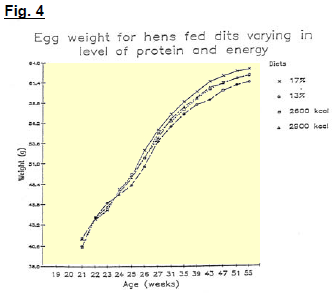 |
Feed intake, as was to be expected, was significantly higher for the low energy diet beyond 20 weeks of age or after the birds had started into production (Figure 5). There was little difference in feed intake of the diets varying in level of protein. While a 31% increase in dietary protein (13 to 17%) resulted in a 2 to 3% increase in egg size, this would translate into a very small increase in the absolute amount of protein in the egg. Thus the efficiency of dietary protein intake to edible protein produced is markedly inferior with the 17 versus the 13% protein diet.
Body weights for the hens were similar at various stages of the production cycle with the exception of heavier body weights at 55 weeks of age for the birds fed the 17 versus the 13% protein diets (Table 5). Heavier body weights for hens fed higher protein diets have been reported previously (Proudfoot et al., 1988 and Summers et al., 1991). As mentioned previously this higher body weight is usually reflected in larger egg size.
There are many reports in the literature suggesting that pullets must be fed diets in excess of 17% protein at the onset of production in order to achieve optimum egg production and egg size. However, in many cases (Keshavarz and Jackson, 1992 and others), pullets were underweight at point of lay and thus higher levels of protein were required in order to bring the pullets up to a mature body weight while at the same time they were coming into production. The reason for underweight pullets is usually due to underfeeding, caused by people restricting feed, by low feed intake resulting for high environmental temperatures, or by pullets stimulated into production using a particular light pattern, at too young a physiological age.

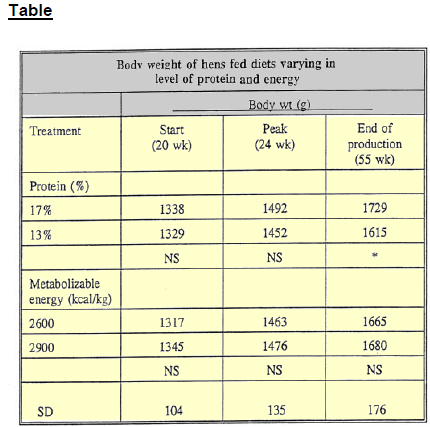
In Figure 6 is shown a good production curve for a modern day layer “A”, and one that is delayed several weeks before reaching peak “B”. With proper pullet body weight modern day hens will reach peak production in 4 to 6 weeks, not 8 to 10 weeks as was the case a few short years ago or as still stated in some production manuals. In Figure 6 is shown a good production type curve for a modern day layer “A”, and one that is delayed several weeks before reaching peak “B”. With proper pullet body weight modern day hens will reach peak production in 4 to 6 weeks, not 8 to 10 weeks as was the case a few short years ago or as still stated in some production manuals. The delayed curve “B”, can be the result of an uneven flock. Many birds in an uneven flock would be underweight and thus they will not come into production until their body weight increases. A flock that is uniform, but underweight, and is brought into production at an early age due to an increasing light pattern during the growing period or by early light stimulation (based on physiological not calendar age) will often show a production curve similar to that demonstrated in Figure 7. Such pullets will start off in production as well as a normal flock, however, they either never peak properly or they may reach peak but dip in production shortly after. Similar type curves may be noted with good pullets fed an inadequate diet as they come into production – the main nutrient deficiency usually being energy.
 |
 |
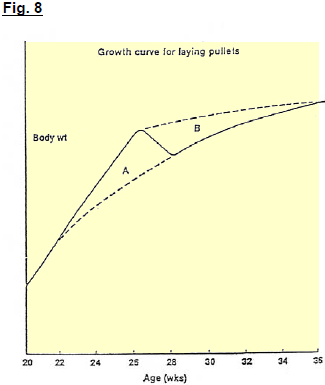 |
Underweight pullets coming into production quickly use up what little body reserves they have and, due to low feed intake at this time, they do not have enough nutrient reserves available to maintain production as well as divert nutrients to body weight gain. In Figure 8 is shown a suggested body weight curve for pullets. Note a decrease in body weight about the time that the flock is reaching peak production. Eventually body weight increases and catches up to what would appear to be normal around the time of peak egg mass. The triangle marked “A”, approximates the amount of body reserves needed by the hen to get it through the period, demonstrated by triangle “B”, when the hen’s nutrient intake is not high enough to meet her requirements for production, weight gain and maintenance.
Why is the feed intake low as the pullet comes into production regardless of strain of bird or diet employed? It is a normal physiological phenomena for a pullet to reduce feed intake several days before and after laying her first egg. This is demonstrated in Figure 9 where Foster (1969) showed that approximately 7 days before the pullet lays her first egg there is a marked reduction in feed intake. It is several days after the first egg is laid that the feed intake returns to normal or expected levels. Similar data from the USA is show in Fig. 10. These workers demonstrated that dietary calcium was in some way involved, since diets low in calcium resulted in the lowest feed intake. It can be noted that birds given free choice oyster shell at point of lay initially consumed large quantities. From the above data it is concluded that pullets should be on a higher level of dietary calcium coming into production, than found in the normal growing diet. In practice many people feed a regular laying diet several weeks before the onset of production. This would appear to be a wise decision.
A reduction in feed intake is thus a normal physiological function as pullets approach the onset of production. This reduction in feed intake, at the second stage of sexual maturity, is the reason why body reserves (body weight) are important for pullets coming into production, since nutrient intake will probably not be sufficient to meet the needs for maintenance and egg production at this time. This is especially true if birds are coming into production in hot weather where feed intake will be further reduced by environmental conditions.
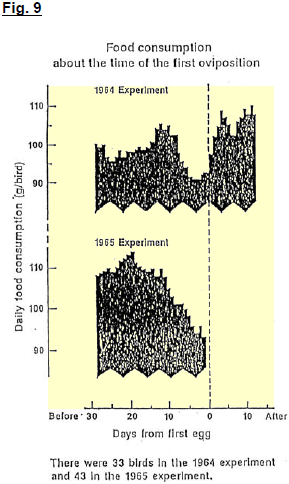 |
 |
 |
In Figure 11 the partitioning of energy intake for a broiler breeder is shown. While the energy requirement of a Leghorn hen would be much lower, the same relative principles apply. It can be noted that only around 20% of the energy goes to egg production. Since the demand for energy, for most body functions takes precedence over that required for egg production, a reduction in feed intake, regardless of how small, could have a significant effect on the amount of energy diverted to egg production and/or egg size. Thus it is important to have good pullet body weight at point of lay and to feed and manage the flock so that a maximum amount of nutrients are diverted to the production of egg mass.
The question is often asked - how can one put additional weight on an underweight or early maturing pullet flock? One must put a little more age on the flock. Thus the birds must be restricted in feed intake and/or kept at a pullet weight for an additional week or two. In Table 6 is shown suggested body weights for a pullet flock at various stages of sexual maturity. Note a weight is given for 18 weeks of age (this will vary depending on type of bird, season of the year, etc.) however, beyond 18 weeks, target weights should be tied to stage of maturity not calendar age. Even with windowless, environmentally controlled houses, it is difficult to completely eliminate the seasonal effect on maturity. Thus pullets will not mature at the same calendar age throughout the year. As pointed out in Table 6, pullets should not be kept at a pullet weight until they are ready to be brought into production. Thus if birds are to be delayed in coming into production in order to achieve a little older pullet, or if they have to be held in the growing facilities for an additional week or so, be sure to keep them at pullet weights so that the flock does not begin to progress toward the second stage of sexual maturity and begin production before the move to the laying house.
This is an extremely important recommendation if pullets are to be transported long distances, especially in hot weather, when significant body weight loss often occurs. Birds that have started to lay can be put out of production, due to stress imposed on them, and when they return to production they may have missed several of the longer “clutch sizes”. The result is that production of the flock will not be maintained at the level it would be for a normal flock. A similar situation may occur when pullets in lay are moved from a growing facility and placed in laying cages with a different watering system. Where pullets are moved short distances and care is taken to minimize stress there is usually little affect on the production patterns of hens.
Some people, in certain parts of the world, routinely restrict feed intake or remove feed completely from a flock at point of lay in order to increase the age at sexual maturity of the flock which in most cases will add weight or improve the uniformity of a flock. There are a number of ways this can be brought about. The following are the results of a trial conducted at the OMAF research facilities at Arkell, where pullets at 18 weeks of age were fed just wheat bran for two weeks as a means of reducing feed intake and thus delaying sexual maturity (Summers et al. 1991) In Figure 12A it can be noted that the pullets weighed around 1350g at 18 weeks of age at which time the flock had just laid its first egg. Onethird of the pullets were continued on a normal laying program and fed a 17% protein corn, soya laying diet. Another third on the flock were fed just wheat bran to 20 weeks of age, while the remaining birds were fed just wheat bran until 1% production. Since 1% production occurred at 20 weeks of age, the two bran treatments were identical. During the 18 to 20 week period the bran fed birds lost around 200 grams of body weight.
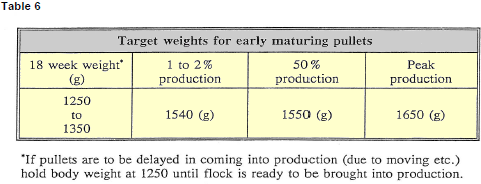
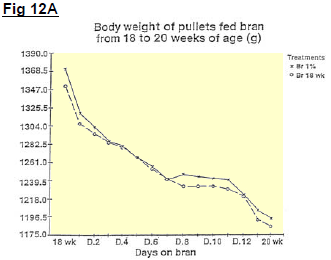 |
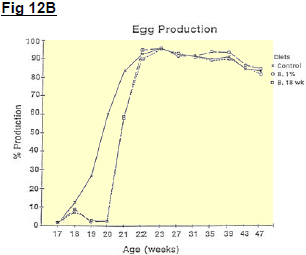 |
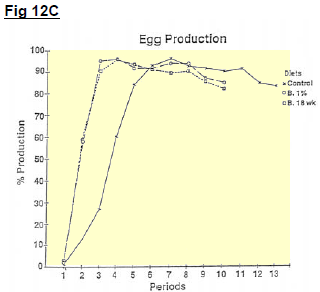 |
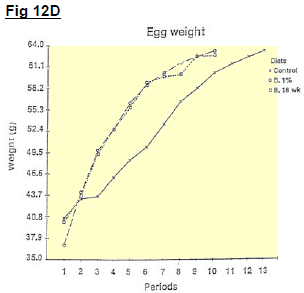 |
It is obvious from the above work that pullets held out of production for a week or so, and thus the second stage of sexual maturity occurring with a slightly older bird, will rise to peak quickly and lay heavier eggs coming into production that pullets brought into production at a younger age.
It is hypothesized that what happens is that when the pullet reaches a mature pullet weight and perhaps, a mature pullet age, oviduct development, as well as other physiological changes related to the onset of production, begin to occur. The pullet is moving from a juvenile to an adult stage. As with most animal species, once the reproductive process has been initiated, nutrients are probably preferentially partitioned to the reproductive organs. Hence, the oviduct of the hen will probably develop during a period of restricted nutrient intake in preference to other body tissues. However, in order for an egg to develop, a major input of nutrients would expect to be required. Thus with some type of nutrient restriction program, just prior to onset of production, many hens may be positioned with relatively well developed oviducts waiting for a significant increase in nutrient intake to stimulate ovulation and thus initiate egg production. Thus egg production will be synchronized with respect to the onset of production and a rapid rise to peak production of the flock will be noted.
As yet no specific recommendations are given with regard to the type of program to follow in order to delay pullets coming into production. It is questionable whether a program, such as outlined above, where pullets lose a significant amount of body weight just prior to production, would be the most economical program to follow. However, it is obvious that some type of nutrient restriction program may be required in order to slow down pullet development just prior to onset of lay if they have developed quickly, or if egg size is a major consideration.
There is enough data available today to indicate that slightly older pullets (and thus heavier body weights) almost always make more profitable layers. This is especially true if egg mass output is a major consideration. Before implementing any change in the type of pullet growing program one is using, prior to onset of production, careful consideration should be given to:
- past flock performance
- season of the year pullets will be brought into production
- degree of stress involved in moving pullets to the laying house
- condition of the pullets as they approach sexual maturity.
Heavier pullets, at point of lay, can achieve optimum peak production and egg size on diets containing lower levels of dietary protein than is the case with lighter weight pullets. This is an important point to consider when deciding on type of laying program to follow. Light weight pullets will show increased egg size and sometimes higher initial production with high protein laying diets. However, a much more economical approach would be to have a heavier pullet at point of lay which will perform satisfactory on low protein diets. Not only does this result in reduced feed costs throughout the laying period but a major reduction in fecal nitrogen excretion is achieved without any loss in egg mass output.
References
Brody, T., Y. Eiton, M. Soller, I. Nir and Z. Nitsan, 1980. Compensatory growth and sexual maturity in broiler females reared under severe food restriction for day of hatching. British Poultry Sci. 21: 437-446
Foster, W.H., 1968. A fall in food consumption immediately prior to first egg. British Poultry Sci. 9: 367-369
Hurwitz, S. and A. Barr, 1971. The effect of pre-laying mineral nutrition on the development, performance and mineral metabolism of pullets. Poultry Sci. 50: 1044-1055.
Keshavarz, K. and M. E. Jackson, 1992. Performance of growing pullets and laying hens fed low-protein amino acid supplement diets. Poultry Sci. 59: 1839-1851.
Leeson, S. and J. D. Summers, 1978. Voluntary food restriction by laying hens mediated through dietary self-selection. British Poultry Sci. 19: 417-424.
Leeson, S. and J. D. Summers, 1980. Effect of early light treatment and diet self-selection on laying performance. Poultry Sci. 59: 11-15.
Leeson, S. and J. D. Summers, 1981. Effect of rearing diet on performance of early maturing pullets. Can. J. Anim. Sci. 61: 743-749.
Leeson, S. and J. D. Summers, 1987. effect of immature body weight on laying performance. Poultry Sci. 66: 1924-1928
Leeson, S., L. Caston, and J. D. Summers, 1991. Significance of physiological age of Leghorn pullets in terms of subsequent reproductive characteristics and economic analysis. Poultry Sci. 70: 37-43.
Leeson, S. and L. Caston, 1991. Growth and development of Leghorn pullets subjected to abrupt changes in environmental temperature and dietary energy level. Poultry Sci. 70: 1732-1738.
Leeson S. and L. Caston 1993. Does environmental temperatures influence body weight: shank length in leghorn pullets? Journal of Applied Poultry Research. 2: 245-248.
Meyer, G. B., S. W. Babcock and M. L. Sunde, 1970. Decreased feed consumption and increased calcium intake associated with pullet’s first egg. Poultry Sci. 49: 1164-1169.
Proudfoot, F. G., H. W. Hulan and K. B. McRae, 1988. Performance comparisons of phased protein dietary regimens fed to commercial Leghorns during the laying period. Poultry Sci. 67: 1447-1454.
Spratt, R. S., 1987. Studies on the utilization of dietary energy by the broiler breeder hens. Ph.D. Thesis. University of Guelph.
Summers, J. D., S. Leeson and D. Spratt, 1987. Rearing early maturing pullets. Poultry Sci. 66:1750-1757.
Summers, J. D., D. Spratt and J. L. Atkinson, 1991. Delaying sexual maturity of pullets by nutrient restriction at the onset of production. Can. J. Anim. Sci. 71: 1215-1221.








